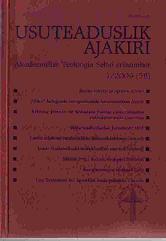Jeesus tekstis ja ajaloos. Ajaloolise Jeesuse uuringu problemaatikast Mäejutluse näitel
Jesus in Text and in History. About the Problems of the Historical Jesus Research Based on the Example of the Sermon of the Mount
Author(s): Ain RiistanSubject(s): Christian Theology and Religion
Published by: Akadeemiline Teoloogia Selts
Keywords: New Testament Studies; Jesus; Matthew
Summary/Abstract: The article studies the implications of the methods used in the historical Jesus research to the outcomes of the study (especially the question of the meaning of the studied text). It is done by outlining in a schematic way the framework in which the questions about the historical Jesus and his message are stated. This framework states the basic questions each scholar has to answer before going on with more detailed analysis. So one can say that different scholars „enter” into that framework with their respective methods and that the outcomes of their research projects are correlated to the answers they give to these basic questions. Firstly, the question about the „author” of the Sermon has to be answered by an interpreter. In one end of the spectrum the author is Jesus himself as a historical figure. In the other end of the same spectrum it can be said that the author is the evangelist who uses the name of Jesus as a vehicle for the message of the gospel text. In this case „Jesus” is a literary character. Secondly there is the question of the intended meaning of the exemplary text (the command to love your enemies in Matthew 5:38-48). Who is the enemy to love? From one point of view it can be said that the meaning is historically conditioned – as most of the people would have considered the Romans as their enemy, the command is about them. In this sense it is the „closed text” of political realities of the day. From another point of view the command to love one’s enemies has been interpreted to be universal. In this case we have the „open text” of daily life where each receiver of the message determines personally (individually or corporately) who is „the enemy”. So the framework follows the graphic pattern, where „Jesus” is observed horizontally and „open text” – „closed text” vertically. Different scholars are set into that framework, e.g. Robert Eisenman, Gerd Theissen and others.
Journal: Usuteaduslik Ajakiri
- Issue Year: 2009
- Issue No: 1 (58)
- Page Range: 4-38
- Page Count: 34
- Language: Estonian

